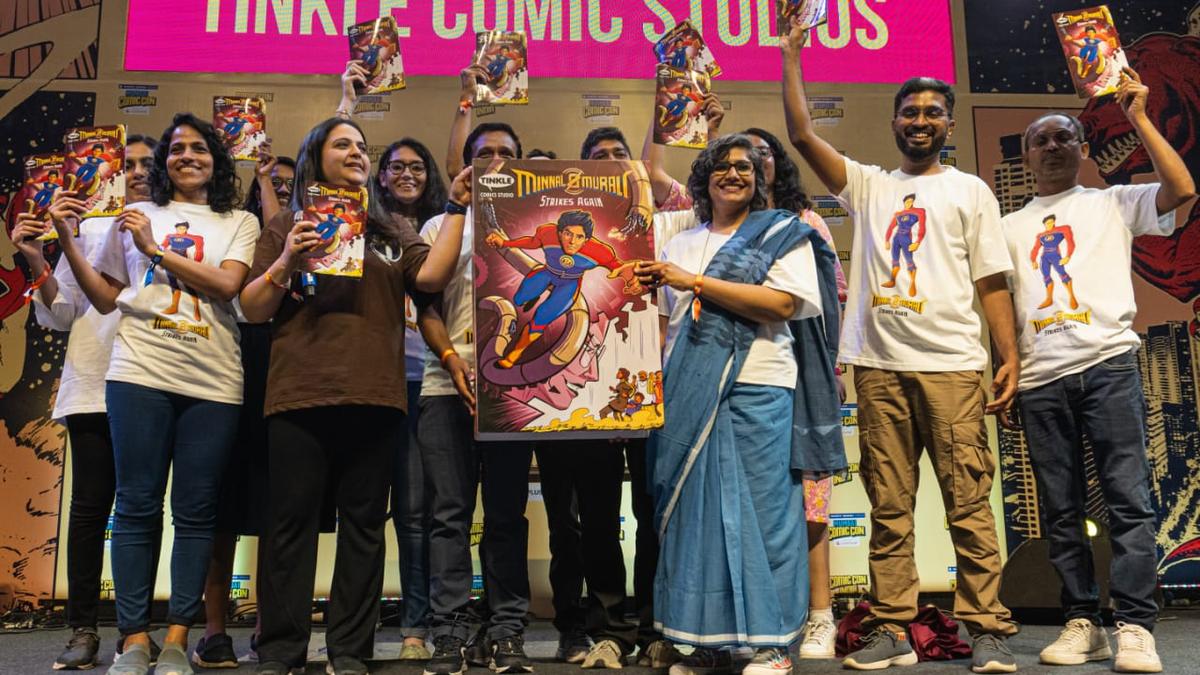
Real world politics has been spilling into Bollywood over the past few months. With elections about to begin, Hindi cinema is also poll-bound
Nothing is as powerful as an idea whose time has come, except when everyone has the same idea. Over a five-week stretch starting 25 January, I saw the same scene play out thrice on the big screen in three different films. First came Fighter, which had a recreation of the attack by a Jaish-e-Mohammed suicide bomber on a Central Reserve Police Force convoy at Pulwama in 2019, in which 40 soldiers were killed. A month later, Article 370 showed the Pulwama attack. A week after that came Operation Valentine, which again recreated the attack and used newsreel footage of the funerals. All three films had actors essaying the role of the prime minister, either attending the funerals or addressing rallies and promising retaliation.
Every other week this year, a film has released that extols the achievements or reflects the concerns of the Bharatiya Janata Party (BJP) and its affiliates—the existence of Pakistan, the rights of Hindus, the abrogation of Article 370 in Jammu and Kashmir. Since the official announcement of the polling dates (19 April to 1 June), there are some restrictions on campaigning. But films continue to play in theatres across the country that openly or tacitly make a case for the ruling dispensation.
“A particular piece of propaganda by itself is unlikely to shift the way somebody votes,” says Aakar Patel, author of Our Hindu Rashtra. “But it all helps. The volume of material—whether it’s through social media or on the big screen or the small screen or radio—will consolidate the message the party is trying to send out.”
These films range from big studio releases to shoestring provocations. Some of the makers have a discernable political agenda; others just want to turn a profit. If we consider only the films released this year, three broad categories emerge: war and foreign policy (Fighter, Operation Valentine); internal politics (Article 370, Bastar: The Naxal Story); and right-wing history (Main Atal Hoon, Swatantra Veer Savarkar, the Telugu film Razakar). There are also a handful of incendiary films with trailers out that could release in the next month-and-a-half: The Sabarmati Report, Accident Or Conspiracy: Godhra, The Diary Of West Bengal, The UP Files, JNU: Jahangir National University. And there’s Emergency, directed by and starring BJP candidate Kangana Ranaut as Indira Gandhi, slated for release on 14 June, after the election results are declared.
This flurry of right-leaning films comes on the back of 10 years of increasingly conservative Hindi cinema. Secular overtures in commercial films—once as common an ingredient as song and dance—are less frequent now. Spy and war films boast of an aggressive “new India”. Dissenting voices have dried up. The idea of India as a Hindu nation is often touted, especially by historical films that portray Muslim kings as cruel invaders and play up the resistance of the Rajputs and Marathas. Meanwhile, films from Brahmāstra: Part One—Shiva (2022) to Ram Setu (2022) to Adipurush (2023) promote different shades of Hinduism, from quasi-science to baroque fantasy.
How has this pronounced slant affected Hindi cinema? Few would argue that Bollywood has made any leaps, or even small hops, in the last five or six years. Compared to other language cinemas, it looks slow-footed and timid, unsure of how to capture the popular imagination or make an incisive point. The slant has as much to do with political climate as it does with opportunism. Films favourable to the government are offered tax breaks (four BJP states made the controversial 2023 film The Kerala Story tax-free), talked up by leaders in rallies, their makers given awards and, occasionally, party tickets (Kangana Ranaut is contesting her first election from the Mandi Lok Sabha constituency in Himachal Pradesh; Arun Govil is standing from Meerut in Uttar Pradesh). It all adds up to a unique situation: one of the largest popular cinemas in the world, overwhelmingly for the State, but not by the State.
PARTY FAVOURS
Exactly three months before the last general election, Aditya Dhar’s Uri: The Surgical Strike (2019) released. It broke with previous Hindi action films in emphasising the role of the government, including the prime minister (played by Rajit Kapur) and national security adviser Govind Bhardwaj (Paresh Rawal), in the covert operation conducted on Pakistani soil in 2016. The prime minister isn’t named, and Kapur doesn’t do any imitations, but styled and presented as he is, audiences are left to draw their own conclusions.
Uri grossed approximately ₹340 crore on a budget of ₹44 crore and ushered in a new kind of hard-edged political action film. In the wake of its success, the film was referenced and its rallying cry (“How’s the josh?”) used by BJP leaders in the run-up to the polls. They are still using its language. “This is new India,” Bhardwaj famously says in the film. “It’ll enter your home, and it’ll kill you too.” Earlier this week, the BJP dropped a minute-long, military-themed video featuring the Prime Minister that begins with “This is new Bharat.”
A lean, focused alternative to the maximalist action favoured by star vehicles, Uri has had an outsize influence on the Hindi cinema of the past five years. New action films reference it unthinkingly, the way romantic dramas quote Dilwale Dulhania Le Jayenge (1995). “How’s the josh?” becomes a silly joke in Fighter (“How’s the ghosht?”); the Ranaut-starrer Tejas (2023) reuses the “enter your home” line verbatim. But it’s Article 370 that takes Uri’s less-appreciated tweak—politicians as prime movers in action thrillers—and creates a new sort of propaganda film.

Aditya Suhas Jambhale’s film is about the abrogation of the erstwhile Article of the Constitution that allowed for “special status” for Jammu and Kashmir. Abrogation had been a long-standing objective of the BJP, mentioned in successive election manifestos. It was achieved in August 2019, and the state was reorganised into two Union Territories of Jammu and Kashmir, and Ladakh. Article 370 is produced and co-written by Uri director Aditya Dhar, and stars his wife, Yami Gautam Dhar, who also featured in Uri. Sharp, strident and divided into “chapters” like in Uri, the film oscillates between efforts to track separatists and the legal and political maneuvering that allowed the abrogation to happen. National Investigation Agency operative Zooni (Gautam) and joint secretary, PMO, Rajeshwari (Priyamani) are the prime movers; also in prominent roles are the prime minister played by Arun Govil—Lord Ram in the popular TV series Ramayan (1987)—and the home minister played by Kiran Karmarkar.
If Uri showed the Prime Minister’s willingness to act decisively, Article 370 is a tribute to his and home minister’s determination to get the job done. Dhar said as much at the trailer launch: “The current government doesn’t need a small film like ours to win an election. They made Ram Mandir for us. It took us 500 years to get that.” At a rally in Sangareddy in Telangana on 5 March, the Prime Minister referenced the film and suggested abrogation and the Ram temple as twin examples of the “Modi guarantee”. The film was also praised by the defence minister, and made tax-free in two BJP states.
Will we see a triumphant Ram Mandir film in 2029? The temple at Ayodhya was finally consecrated on 22 January, on the site of the erstwhile Babri mosque. The ceremony was attended by a galaxy of Bollywood stars, including Alia Bhatt, Ranbir Kapoor, Amitabh Bachchan, Vicky Kaushal, Katrina Kaif and Madhuri Dixit Nene. All four hours were screened in PVR Inox cinemas in over 70 cities. A friend who sat through it said there wasn’t an empty seat in the hall, even though it was Monday morning.
Reclaiming Ram Janmabhoomi was the primary emotive BJP issue for decades. There are a few little-seen, alarmist films (Ram Ki Janmabhoomi, 2019; Six Nine Five, 2024) about the movement itself. The last act of Tejas has Ranaut’s fighter pilot scrambling to prevent a terrorist attack on a Ram temple about to be inaugurated. The Akshay Kumar-starrer Ram Setu can be seen as an allegory for the movement, the mythical bridge from India to Sri Lanka standing in for another Hindu structure lost in the mists of time, whose veracity is decided at the end by a court case.
Ram the deity remains a huge draw. Adipurush, a ludicrous, VFX-heavy retelling of the story of Ram, was a failure, but that hasn’t put a dampener on a proposed Ramayan trilogy with Ranbir Kapoor (who already has one Hindu mythology-inspired franchise in Brahmastra) as Ram.
JOIN THE ASSISTANCE
Shohini Ghosh, professor, AJK Mass Communication Research Centre Jamia Millia Islamia, Delhi, says that although she’s sceptical about the recent glut of pro-establishment films affecting voting decisions, they do “give us an insight into how the agenda of Hindutva, of right-of-centre nationalism, has permeated Bombay cinema. Politics has become inescapable.” She points out how Siddharth Anand in his action films War (2019) and Pathaan (2023) succeeded in “troubling the idea of the enemy”, but didn’t in the more strident Fighter. A casualty, perhaps, of being a pre-election release.
The polls might have shone a light on establishment-friendly cinema, but this has been an ongoing trend. Hindi cinema has moved steadily rightwards over the last decade, towards Hindutva and hawkishness and away from social criticism and inclusivity. At the same time, the box office has ceded more and more ground to Hollywood. The genre spectaculars that have tried to wrest back that audience have been spy films, war films and historicals—genres that, in India, are inherently conservative, pro-government and sometimes Hindutva-leaning.
The Hindi blockbuster space today is a fascinating web of historical revisionism, ancient grudges and geopolitical posturing. Hindu iconography is all-pervasive, from the eve-of-battle prayers in war film Bhuj: The Pride Of India (2021) to the unexplained underwater aums in Ram Setu. Historical films sell the Hindutva belief that India was ruled by “invaders” from the death of Prithviraj Chauhan in 1192 right up till independence from the British in 1947. War and spy films also play on the threat of incursion (always Pakistan, rarely China), but show an India that isn’t “afraid to use force”. Kashmir is a source of anxiety, or outright villainy, in many of these films; one of the ugliest moments in Fighter is Hrithik Roshan’s air force pilot growling, with reference to Kashmir, “Maalik hum hain (we are the masters)”. The prime minister in the film says “Unhe dikhana padega ke baap kaun hai (we’ll have to show Pakistan who daddy is)”, and indicates that this is something the governments of the last five decades were too timid to do. Compared to this, the social message films built around BJP-era initiatives—like the Akshay Kumar-starrers Toilet: Ek Prem Katha (2017) and Mission Mangal (2019)—feel quite benign.

When it comes to films concerning earlier regimes—both BJP-led and otherwise—a complicated dance ensues. Sam Bahadur (2023) credits Field Marshall Sam Manekshaw (Vicky Kaushal) with the entirety of the 1971 Bangladesh liberation campaign, regarded as one of India’s greatest military successes. In the film, Jawaharlal Nehru (Neeraj Kabi) is a weak old man who allows China and Pakistan to threaten India. Indira Gandhi (Fatima Sana Shaikh) is green and unsure, deferring to Manekshaw in matters of strategy and diplomatic action. He addresses her as “sweetie”; they have a few moments bordering on flirtation. It’s not a mean portrait of Gandhi, but arguably one that diminishes her steely acumen, just as The Accidental Prime Minister (2019) diminished Congress leader and former Prime Minister Manmohan Singh’s capabilities.
Yodha (2023) has the opposite problem. This 15 March release with Sidharth Malhotra as a special forces soldier is loosely inspired by the 1999 Indian Airlines Flight 814 hijack that led to the release of terrorists Ahmed Omar Saeed Sheikh, Masood Azhar and Mushtaq Ahmed Zargar. Though the BJP-led National Democratic Alliance was in power in 1999 (and in 2001, which is when the hijack in Yodha happens), the film hints it was a Congress government by partly blaming the hijack on a dithering politician who refuses to allow commandos to storm the plane without the go-ahead of “high command”, a term generally used for the Gandhi family. The film ties itself in knots to avoid references to then Prime Minister Atal Bihari Vajpayee, to the extent of not identifying the character played by Sanjay Gurbaxani as PM at all (he’s referred to as “head of state”, which in India is the President). Yet, he’s clearly meant to be the PM, and is shown travelling to Pakistan for a peace summit, as Vajpayee did.
A far more insidious film opened on the same day as Yodha. Bastar: The Naxal Story is the second collaboration between director Sudipto Sen, actor Adah Sharma and producer Vipul Amrutlal Shah after last year’s runaway hit The Kerala Story, a fear-mongering and largely inaccurate story of Malayali Muslim men tricking young women into joining the Islamic State. At a rally in Ballari ahead of the Karnataka state election in May last year, the Prime Minister said the film had “exposed terrorist conspiracies taking place in the beautiful state of Kerala” and that “the Congress is striking backdoor political deals with people with terrorist tendencies”.
Bastar, which presents the Naxals as a well-funded terrorist outfit, unfolds in the late 2000s, and recreates the 2010 Dantewada ambush, in which 76 CRPF personnel were killed. The BJP was then in power in Chhattisgarh and the Congress-led United Progressive Alliance (UPA) at the Centre. The minister whom Sharma’s straight-shooting CRPF officer clashes with is probably meant to be a home minister. There’s a flurry of disclaimers at the end, with unsubstantiated numbers indicating that the region has changed for the better in the last decade.
Bastar echoes the party line on other matters as well. Students at Delhi’s Jawaharlal Nehru University, which has consistently been in the cross-hairs of the BJP, are shown celebrating a massacre by Naxals. A famous liberal writer, Vanya Roy (Raima Sen), acts as a liaison between wine-drinking Delhi liberals, leftist leaders and Naxal fighters—Sen’s idea of an Arundhati Roy type (she’s shown reading Roy’s Walking With The Comrades). Despite its childish provocations, this is a repellent film. Sudipto Sen pulls a leaf from the classic propaganda playbook, showing Naxals as depraved, bloodthirsty and animalistic; the scene with a soldier spilling as she eats reminded me of the Black man gnawing at a chicken leg in D.W. Griffith’s noxious 1915 landmark, The Birth Of A Nation. It’s difficult to take Sen’s film seriously—there’s a meeting in the jungle attended by representatives of the Naxals, LTTE, Lashkar-e-Taiba, ULFA and communist parties of Spain and the Philippines. Yet, the vitriol is real and unsettling.
CULTS OF PERSONALITY
In March, a BJP worker approached the Election Commission to ban the films of Kannada actor Shivarajkumar, whose wife Geetha is contesting as a Congress candidate, until the elections are over. The request was denied, but there’s some irony in its coming from a party worker whose leader is all over the big screen, albeit in slightly altered avatars, as the country goes to polls.
This year itself, we have seen Modi doppelgangers in Article 370, Operation Valentine and Six Nine Five. There are the prime ministers of Uri and Fighter, who only partially resemble Modi but fit the popular perception of him. The Prime Minister’s voice is heard in the climactic scenes of two madly patriotic space films, Mission Mangal and Rocketry: The Nambi Effect (2022); the latter was inexplicably judged Best Film at the 69th National Awards. Avrodh: The Siege Within (2020), a series on the Uri attack and the retaliatory surgical strikes, and its standalone 2022 sequel about how the BJP brought in demonetisation to combat terrorism, had the prime minister as a prominent characters. Another series, Modi: Journey Of A Common Man (2019-20), tracked his rise from childhood. And, of course, there’s PM Narendra Modi, a biopic with Vivek Oberoi as the PM that released just after the 2019 election.

The BJP isn’t the only party to use film to its advantage. There is a long history in this country of politicians benefitting from popular cinema. In the years after independence, Jawaharlal Nehru’s Congress was aided by filmmakers buoyed by a sense of national duty. In his book Planning Democracy, Nikhil Menon tracks how the Five-Year Plans turned up in the 1957 Dilip Kumar hit Naya Daur; in K.A. Abbas’ Char Dil Char Rahein (1959); and in a song in the 1956 film Kya Baat Hai (“We will ensure the success of the Five-Year Plan”). Chetan Anand’s war film Haqeeqat (1964), dedicated to Nehru, was a propaganda kindness, an account of the Sino-Indian War of 1962 which softens the debilitating loss it was for the military and Nehru’s reputation.
Even more remarkable is the case of the Dravida Munnetra Kazhagam (DMK), which engineered, in the words of film scholar Ashish Rajadhyaksha, “one of the great moments of 20th-century propaganda cinema anywhere”. Their leaders—most famously actor M.G. Ramachandran and writer M. Karunanidhi—made dozens of wildly popular films that functioned as political mission statements.
Historian M.S.S. Pandian writes in The Image Trap: M.G. Ramachandran In Film And Politics of an election promise in 1967 to provide 4.8 kilograms of rice at the nominal price of one rupee. This became a song praising the government in the 1968 MGR film Oli Vilakku: When a measure of rice/is sold for a rupee/why should we go begging. It was implemented “with obvious reluctance” when the party came to power.
When journalist Vaasanthi writes in Cut-outs, Caste and Cine Stars that “The dramatic expressions of popular (Tamil) cinema are seen reflected in the expressions of real-life politics as if the movies were just one arena for colourful dramas,” she could be describing the rhetoric of some present-day BJP leaders. But there’s a fundamental difference: the DMK’s was an authored propaganda, while the pro-government films of recent years are made by people with a variety of interests: some in the party, others close to it, some with no particular political outlook.
DISABLING DISSENT
Last week I watched, via private screener, Dibakar Banerjee’s Tees, a film commissioned by Netflix but never released. Its three timelines span past, present and future—Kashmir in the uneasy days before the exodus of the Pandits; the Mumbai of today; and a heavily surveilled future two decades from now—seen through the eyes of one Muslim family. The arcs are presented non-chronologically, as if to compel the viewer to piece together a timeline of national failures. It’s a sombre film, but Banerjee does have some fun. A writer (played by Shashank Arora) is summoned by the literature committee to discuss an innocuous cookbook he’s submitted in the hope of being left alone. They are unhappy with “Kashmiri” being attached to dum aloo, and also that 18% of the words in the manuscript are Urdu. It’s a send-up of censor board meetings by a director who’s seen his share.
I’d expected a howl of despair, but Tees is more thoughtful and pained than angry. It’s the sort of film that could conceivably draw viewers through word-of-mouth on a streaming platform. But Indian streaming has been tamed, with makers under intense pressure to excise political content. Banerjee says the targeting of the Amazon Prime political series Tandav (2021) was a tipping point. “The government calculated correctly that a large part of the film community is in it to maintain their social status, their prestige, not to say something provocative. The moment you put a hold on the privileges, they are quite ready to cave in. They sussed out the film community correctly, pressed the right buttons. Everybody toed the line.”
Dissent in Hindi film today, while not entirely absent, is sporadic. There’s nothing with the bite of the politically minded films from the early years of the current government like Haider (2014) or Mukkabaaz (2017). Still, two films from last year, Bheed and Afwaah, managed theatrical releases despite being critical of the government. A lot was also made of Shah Rukh Khan in Jawan (2023) telling viewers heading into an election year to vote carefully. Tougher criticisms, and far more innovative filmmaking, can be found in recent Hindi non-fiction cinema: Vivek (2018), The Great Abandonment and A Night of Knowing Nothing in 2021, All That Breathes, Writing With Fire and While We Watched in 2022. But outspoken political documentaries rarely make it to streaming platforms or show outside of a few festivals here.
It’s a very different Bollywood from six or seven years ago. The Film Certification Appellate Tribunal (FCAT)—a vital option for redressal if the censors blocked your film’s release— was abolished in 2021. The proposed Broadcasting Bill, if passed, will result in even greater State control over the streaming space. In big and small ways, the government has slowly tightened the screws on the industry. “The celebration of lack of meaning will continue,” Banerjee says. “And in this the film-makers and the audience will collude.
In the 1958 film Phir Subha Hogi, Sahir Ludhianvi turned Allama Iqbal’s Tarana-e-Milli on its head in a stunning critique of Nehru’s India: Cheen-o-Arab humara, Hindustan humara/Rehne ko ghar nahin hai, saara jahaan humara (China and Arabia are ours, India is also ours/There is no roof over our heads/yet the entire world is ours). Contrast this with the bland boasting of Vande Mataram (The Fighter Anthem) in 2024—India is a celebration, winning is in our every fibre, even enemies salute us. Election film season will be over soon, but Hindi cinema’s crisis of confidence looks likely to continue. The first step to recovery is to stop flattering the powers that be.
Source | Powered by Yes Mom Hosting





